
Vortex Structures Uncovered in Solar Cell and Lighting Materials
by Clarence Oxford
Los Angeles CA (SPX) Jun 26, 2024
Metal-halide perovskites have rapidly advanced in the past decade, demonstrating superior performance to silicon in converting light to electric current.
Simulations on TACC’s Frontera and Lonestar6 supercomputers have uncovered unexpected vortex structures in quasiparticles called polarons, which play a role in electricity generation from sunlight.
This discovery is poised to help scientists develop new solar cells and eco-friendly LED lighting, which is seen as a sustainable technology for future illumination.
“We found that electrons form localized, narrow wave packets, which are known as polarons. These ‘lumps of charge’ – the quasiparticle polarons – endow perovskites with peculiar properties,” said Feliciano Giustino, professor of Physics and W. A. ‘Tex’ Moncrief, Jr. Chair of Quantum Materials Engineering at the College of Natural Sciences and core faculty at the Oden Institute for Computational Engineering and Sciences (Oden Institute) at UT Austin.
Giustino co-authored the research on polarons in halide perovskites, published in March 2024 in the Proceedings of the National Academy of Sciences.
“These polarons show very intriguing patterns. The atoms rotate around the electron and form vortices that had never been observed before,” said Giustino, who also is the director of the Center for Quantum Materials Engineering at the Oden Institute.
The vortex structures of polarons may help maintain electrons in an excited state, a condition achieved when a photon of light collides with the atomic compounds.
“We suspect that this strange vortex structure prevents the electron from going back to the unexcited energy level,” Giustino explained. “This vortex is a protected topological structure in the halide perovskite lattice material that remains in place for a long time and allows the electrons to flow without losing energy.”
Perovskite structures have been known for over a century since Gustav Rose discovered calcium titanium oxide perovskite CaTiO3 in 1839. More recently, in 2012, Giustino worked with Henry Snaith’s group at Oxford University, discovering halide perovskites, where halogens replace oxygen, forming salts with metals.
“It turns out that halide perovskites in solar cells show exceptional energy conversion efficiency,” Giustino said.
Compared to silicon’s top efficiency of about 25 percent, achieved after 70 years of development, halide perovskites reached this efficiency within just 10 years.
“This is a revolutionary material,” Giustino said. “That explains why many research groups working on photovoltaics have moved to perovskites, because they are very promising. Our contribution looked at the fundamentals using computational methods to delve into the properties of these compounds at the level of individual atoms.”
For the study, Giustino utilized resources on the Lonestar6 and Frontera supercomputers awarded by the Texas Advanced Computing Center (TACC) and U.S. Department of Energy (DOE) supercomputers at the National Energy Research Scientific Computing Center (NERSC).
“This research is part of a project sponsored by the Department of Energy that has been going on for several years with the support of TACC and in particular Frontera, where we developed methodologies to study how electrons interact with the underlying atomic lattice,” Giustino said.
Giustino noted that studying large polarons in halide perovskites required simulation cells of about half a million atoms, a task unmanageable with standard methods.
To handle these calculations, Giustino and his collaborators at Austin and beyond developed EPW, an open-source Fortran and message passing interface code that calculates properties related to electron-phonon interaction. This code, developed through an international collaboration led by Giustino, specializes in examining how electrons interact with vibrations in the lattice, causing polaron formation.
“Our collaboration with TACC is more than using advanced computing resources,” Giustino said. “The most important part is the interaction with the people. They’ve been essential in helping us profile the code and making sure we avoid bottlenecks by applying profiling tools that help us study performance decreases. Much of the work happening on the EPW code is in collaboration with TACC experts that help us improve scaling the code to get optimal performance on the supercomputers.”
Giustino’s polaron research is part of TACC’s Characteristic Science Applications (CSA) program funded by the National Science Foundation (NSF). Approximately a dozen CSA projects will influence the design of the NSF Leadership-Class Computing Facility, Horizon, under development at TACC.
“The CSA work between my group and TACC to optimize the EPW code allows us to push the frontiers of what one can investigate in understanding and discovering new, important materials. It’s a combination of theory, algorithms, and high performance computing with much back and forth with our colleagues at TACC to make sure that we use the supercomputers in the most viable way possible,” Giustino said.
Another potential application is the development of ferroelectric memory devices, which could lead to more compact computer memory. In these devices, information is encoded by the vibration of atoms in a crystal under an applied electric field.
“Investment in high performance computing and future computing is essential to science,” Giustino concluded. “It requires large investments like the ones that sustain and expand facilities like TACC.”
Research Report:Topological polarons in halide perovskites
Related Links
The University of Texas at Austin
All About Solar Energy at SolarDaily.com
- SEO Powered Content & PR Distribution. Get Amplified Today.
- PlatoData.Network Vertical Generative Ai. Empower Yourself. Access Here.
- PlatoAiStream. Web3 Intelligence. Knowledge Amplified. Access Here.
- PlatoESG. Carbon, CleanTech, Energy, Environment, Solar, Waste Management. Access Here.
- PlatoHealth. Biotech and Clinical Trials Intelligence. Access Here.
- Source: https://www.solardaily.com/reports/Vortex_Structures_Uncovered_in_Solar_Cell_and_Lighting_Materials_999.html
